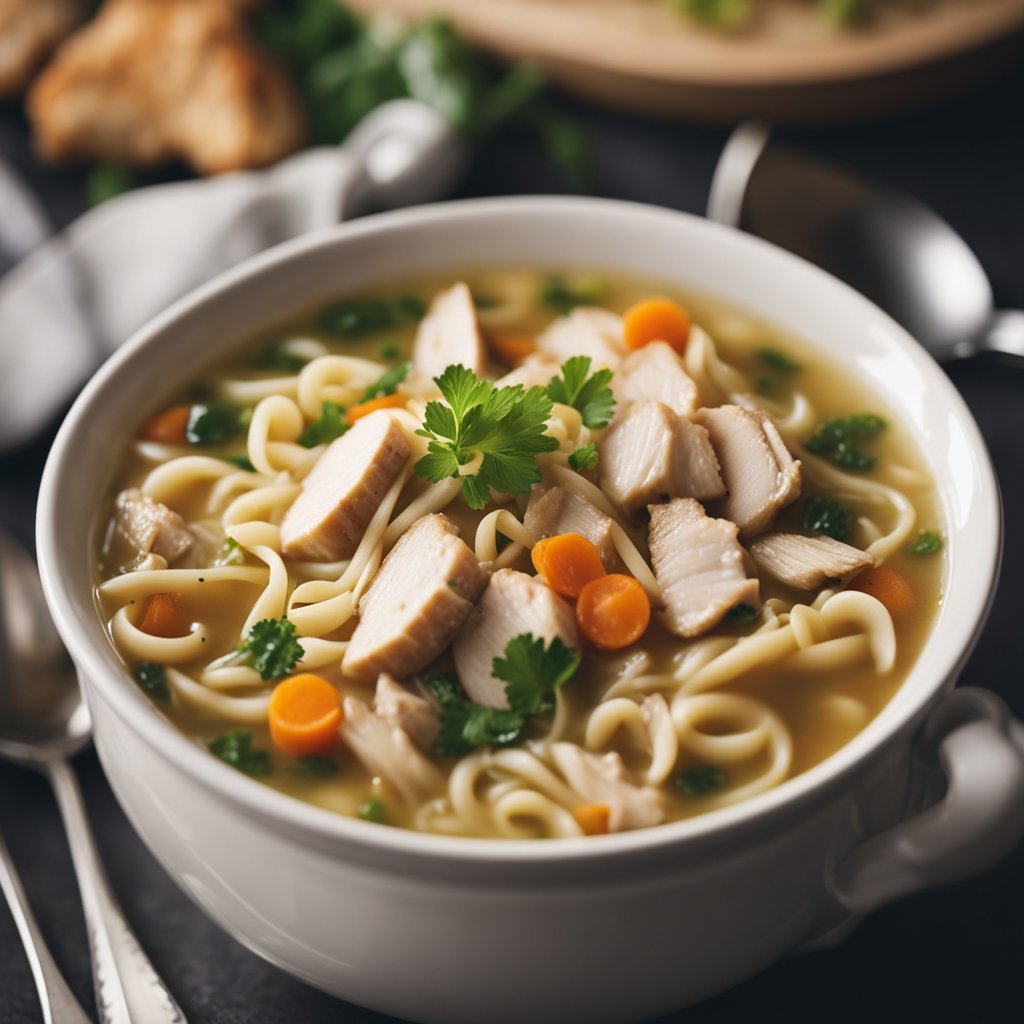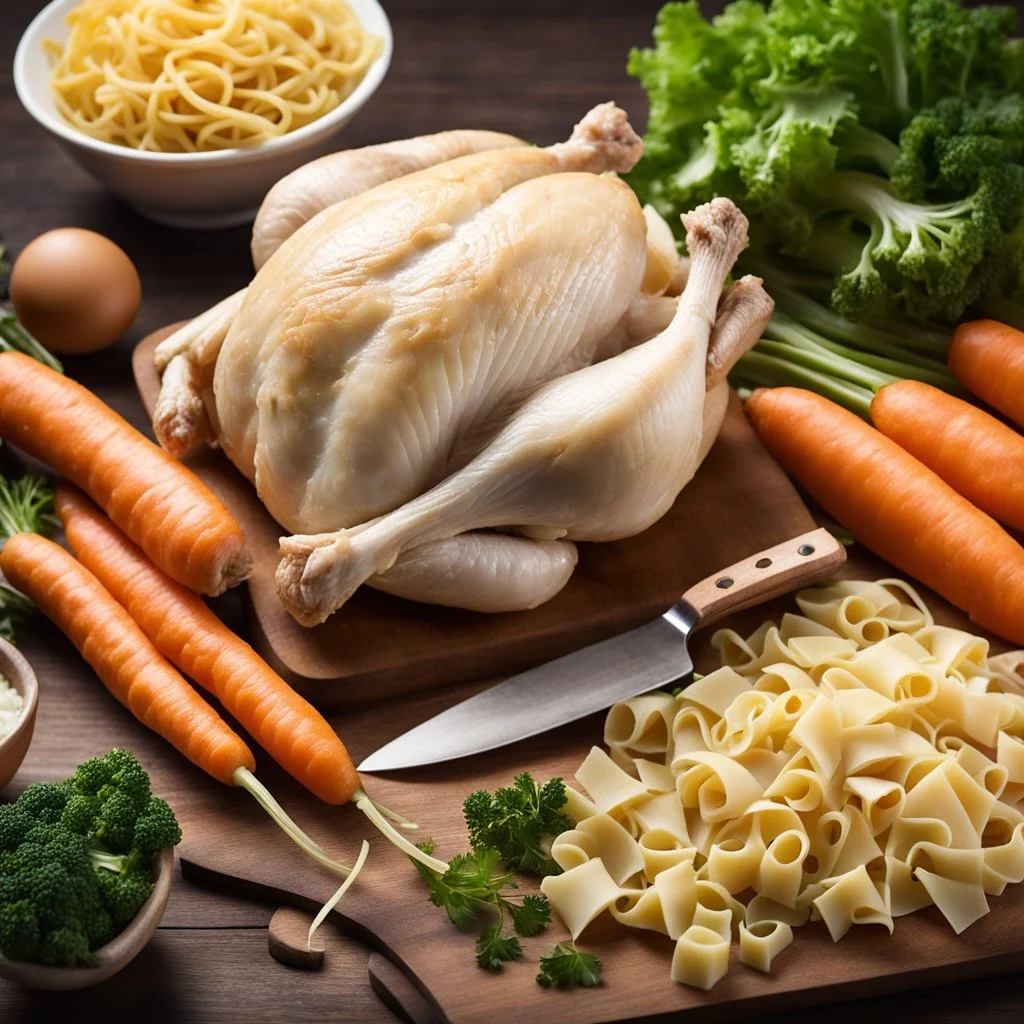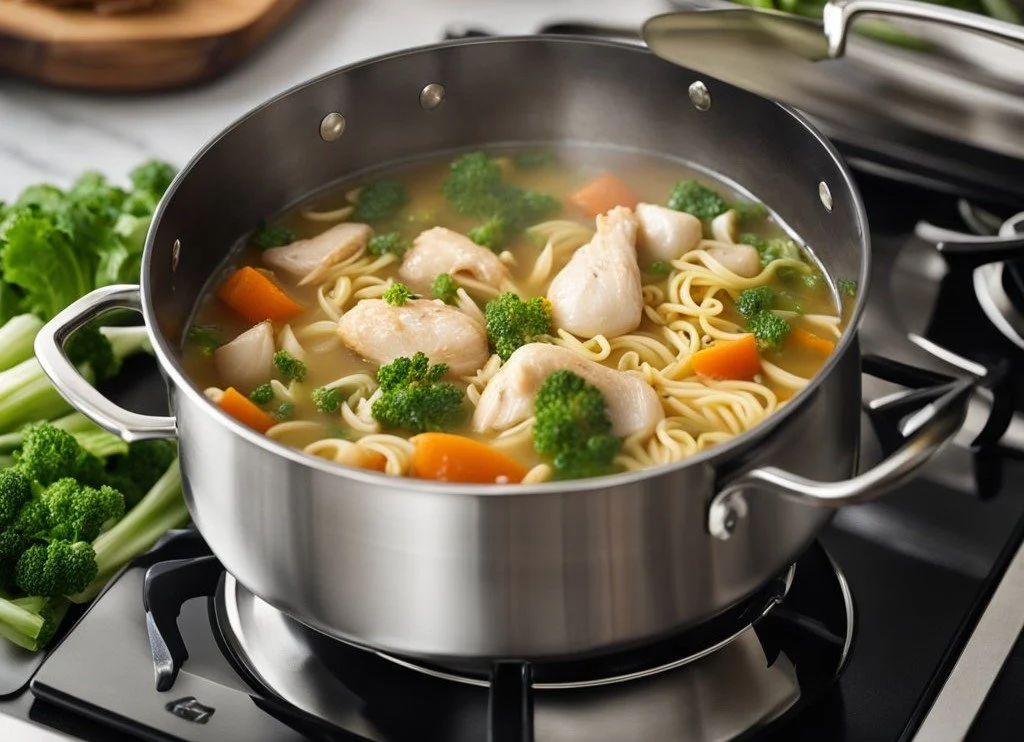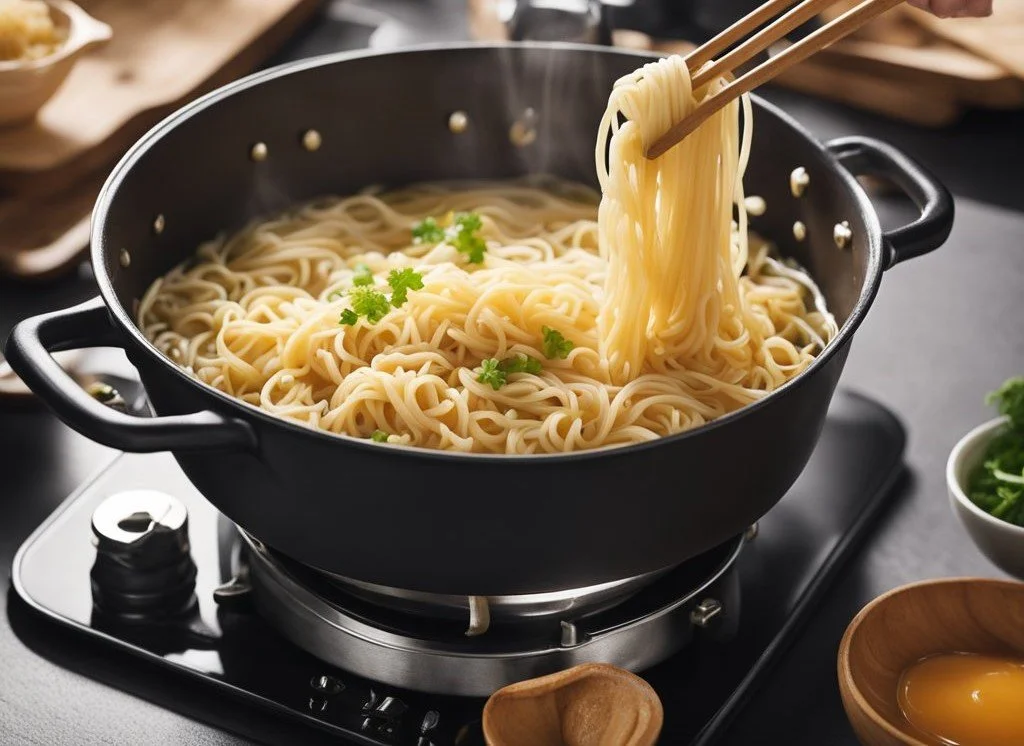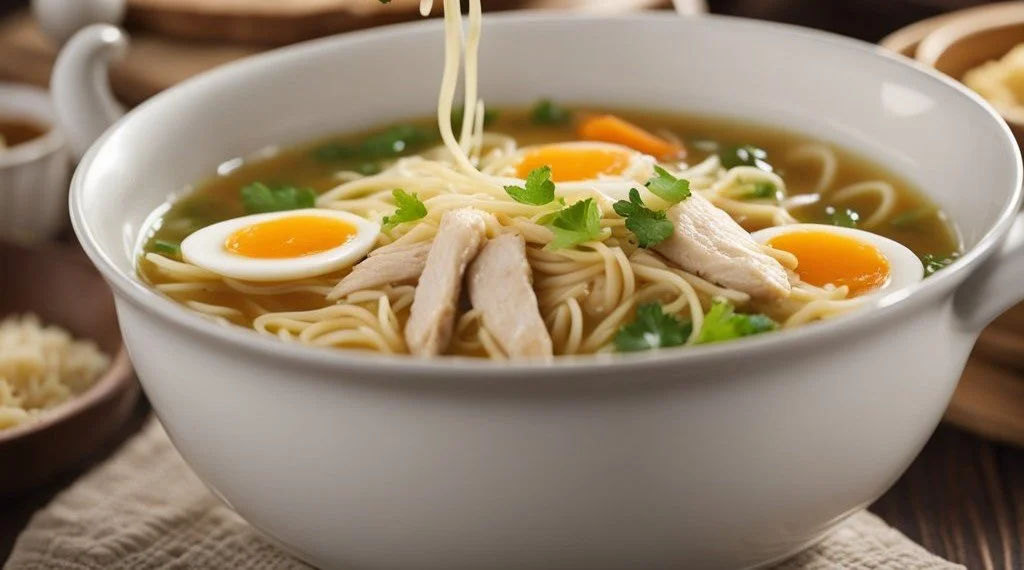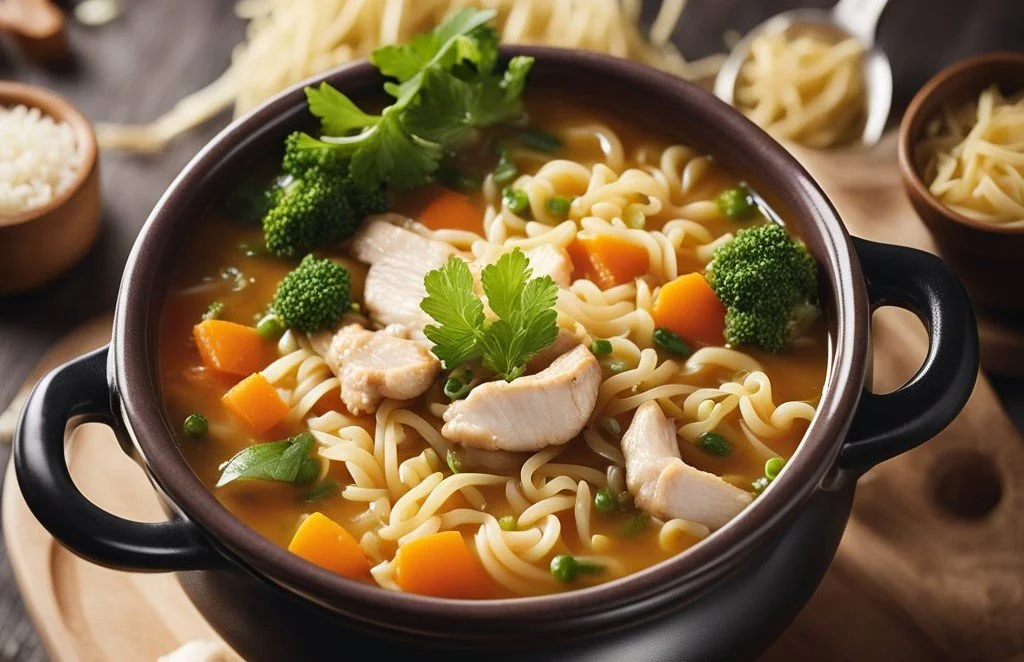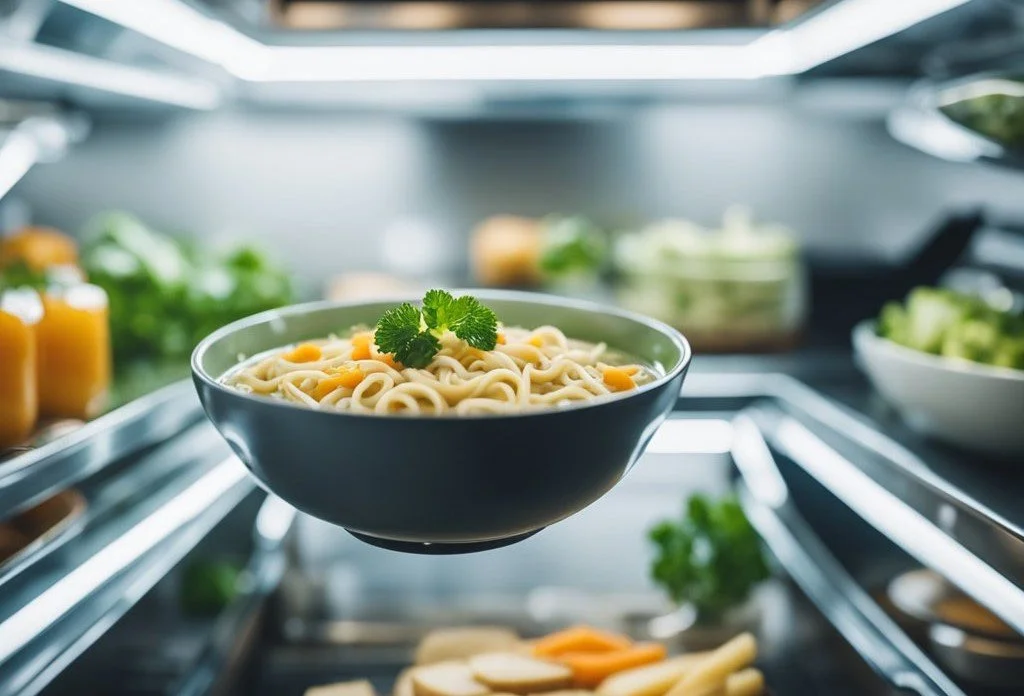Roast Chicken Noodle Soup
A Flavorful and Comforting Classic
Discover > Texas Recipes > Roast Chicken Noodle Soup
Roast Chicken Noodle Soup is a classic comfort food that warms your heart and soothes your soul. This award-winning recipe modified from the traditional chicken noodle soup features a fresh and savory twist by incorporating roasted chicken. (What wine goes well with roasted chicken?) The introduction of roasted whole chicken, not only adds a depth of flavor but also enhances the richness of the soup.
The key to making a delicious homemade Roast Chicken Noodle Soup lies in using quality ingredients and a well-balanced combination of herbs and spices. This hearty dish is perfect for enjoying with family and friends on a cold, rainy day and is appreciated by people of all ages. A bowl of Roast Chicken Noodle Soup is a simple yet satisfying meal that is sure to leave you craving more.
With a well-tested recipe at hand, crafting the perfect Roast Chicken Noodle Soup requires only a few basic steps. By following these instructions, even novice cooks can achieve a scrumptious, full homemade chicken soup, soup that will leave them feeling both accomplished and content. The aroma of the roasted chicken, combined with the enticing fragrance of fresh herbs (how long do fresh herbs last?) and vegetables, will make this dish an instant hit in any household.
Understanding The Ingredients
Choosing Quality Chicken
When making a roast chicken noodle soup, the quality of the chicken is crucial. Opt for fresh, free-range or organic chickens, as they tend to have better flavor and texture. . Rotisserie chicken noodle soup can also be a convenient and tasty option. When possible, avoid chickens with added hormones or antibiotics.
Selecting Fresh Vegetables
A variety of fresh vegetables can be added to your soup, such as carrots (how long do carrots last?), celery (how long does celery last?), onion, zucchini, kale, and even mirepoix which is a mixture of carrots, celery, and onion. Be sure to select vegetables that are firm, vibrant in color, and free of blemishes or bruises.
Carrots
Ideal Characteristics: Smooth skin, bright orange color, crisp texture
Celery
Ideal Characteristics: Firm stalks, vibrant green color, taut leaves
Onion
Ideal Characteristics: Firm to the touch, shiny skin, no sprouting
Zucchini
Ideal Characteristics: Even color, firm texture, no soft spots
The Role of Herbs and Seasonings
Herbs and seasonings play a significant role in enhancing the flavor and aroma of your roast chicken noodle soup. Fresh herbs such as thyme, oregano, parsley, rosemary, and bay leaf can be added to your roasted chicken soup, broth or stock, while dried herbs (how long do dried herbs last?) like Italian seasoning can also be used for convenience.
Here are a few common herbs and seasonings:
Garlic
Adds depth of flavor and aroma; can be minced or sliced.
Thyme, Oregano, Parsley, and Rosemary
Brings out the flavors of the chicken and vegetables.
Bay Leaf
Imparts a subtle, earthy taste to the broth.
Salt and black pepper
Enhances the natural flavors of the ingredients.
Remember that fresh herbs generally pack a stronger flavor, so adjust the amount used accordingly when compared to dried herbs. Finally, be sure to taste your soup throughout the cooking process and adjust seasonings as necessary to achieve a well-balanced, flavorful soup.
If you can’t find these ingredients in your local markets, you can order thyme, oregano, parsley, rosemary, bay leaf, salt, and black pepper online!
Preparation Methods
Sautéing Process
Begin the Roast Chicken Noodle Soup by sautéing the ingredients. In a Dutch oven, heat a mixture of olive oil and butter over medium heat. Add diced yellow onion and sauté until it becomes translucent and slightly golden. Sautéing the onion in both olive oil and butter provides a balance of flavors, ensures even cooking, and prevents burning.
When it comes to getting the best deals, buying olive oil online is the way to go!
Simmering Techniques
Next, focus on the simmering process. After sautéing the onions, (What wine goes well with onions?) add the chicken, vegetables, and broth to the Dutch oven. Bring the mixture to a boil, then reduce the heat and let it simmer, allowing the flavors to meld and the chicken to cook through. Simmering is essential for tender, flavorful meat and a rich, aromatic broth.
Roasting for Richness
For added depth of flavor, consider roasting the chicken before adding it to the soup. To do this, preheat the oven and coat the chicken pieces in olive oil, salt, and pepper. Arrange the whole chicken thighs (What wine goes well with chicken thighs?) on a baking sheet and roast until the skin is crispy and the meat is cooked through. Once ready, shred the chicken and add it to the Dutch oven. Roasting the chicken beforehand enhances the soup's richness and adds a delightful textural element.
For the most extensive selection, I suggest buying baking sheets online!
Building A Flavorful Broth
When creating a delicious roast chicken noodle soup, the foundation lies in building a flavorful broth. Begin by using a balance of fat and water to extract the most flavor from the ingredients. Utilizing a homemade chicken broth (how long does chicken broth last?) or homemade chicken stock will elevate the taste, providing a rich and savory base.
Incorporating dried seasonings and herbs, such as fresh thyme and black peppercorn, will enhance the soup's aroma and complexity. Be cautious not to overpower the broth with too many spices, as allowing the natural flavors of the chicken and vegetables to shine through is crucial. Simmering the broth for an extended period is necessary, as it allows the various flavors to meld together harmoniously.
A well-rounded broth should include various sources of umami, which contribute to the overall depth of flavor. Additionally, consider using a combination of fresh and dried herbs to extract the most essence from them. Remember that moderation is key, with the primary focus being on complementing, rather than overshadowing the chicken and other ingredients.
In summary, a flavorful broth provides the foundation for a mouthwatering roast chicken noodle soup. Utilize a homemade chicken broth or stock, seasoned with a balanced blend of herbs and spices, while allowing ample time for simmering to create a harmonious and delectable dish.
Noodle Selection And Preparation
Egg Noodles
Egg noodles (how long do egg noodles last?) are a popular choice for roast chicken noodle soup due to their rich and hearty texture. Made from wheat flour, water, and eggs, these noodles are available in various widths and can be purchased fresh, dried, or frozen. To prepare egg noodles for your soup, follow these steps:
Boil a pot of water and add a pinch of salt.
Add the egg noodles to the boiling water.
Cook the noodles for the recommended time on the package or until they reach your desired texture.
Drain the noodles and rinse them with cold water to stop the cooking process.
Set the noodles aside and add them to the soup just before serving to prevent them from becoming too soft.
Note: Wide egg noodles are a great option for a heartier soup, as they hold up better in the broth and provide a more filling bite.
Macaroni
Macaroni, a type of pasta (how long does pasta last?), can also be used in roast chicken noodle soup for a different spin on the traditional recipe. This tube-shaped pasta is versatile and pairs well with the flavors of the soup. Preparing macaroni for your homemade chicken noodle soup is similar to the process for egg noodles:
Bring a pot of water to a boil with a pinch of salt added.
Add the macaroni to the boiling water.
Cook the pasta for the suggested time on the package or until al dente.
Drain the macaroni and rinse with cold water to halt the cooking process.
Add the cooked macaroni to the soup just before serving to maintain its texture and prevent overcooking.
In summary, both egg noodles and macaroni can be used in roast chicken noodle soup, with each offering its unique taste and texture.
Assembling And Cooking The Soup
Begin by preparing all the ingredients as follows: shred the cooked chicken, dice the potatoes, and strip the rosemary from its stem. Once everything is prepped, it's time to assemble and cook the Roast Chicken Noodle Soup.
First, heat a large pot over medium heat. Add some oil and sauté the onions, carrots, and celery until they soften. Then, add the rosemary and let it release its aroma before incorporating the shredded chicken into the mix. Stir well to combine all the ingredients evenly in the pot.
Next, it's essential to add the stock to the pot. Ensure that it covers all the ingredients to allow for an evenly cooked and flavorful soup. Bring the mixture to a gentle boil and then reduce the heat to a simmer. Add the diced potatoes and corn, allowing the soup to simmer until the potatoes are cooked through.
As the soup simmers, cook the noodles separately according to the package instructions. Once cooked, drain the noodles and set them aside.
When the potatoes are tender, it's time to add the cooked noodles to the soup. Carefully mix the noodles into the simmering chicken soup to distribute them evenly. Allow the Roast Chicken Noodle Soup to simmer for an additional 5 minutes, ensuring all the flavors meld together.
Your Roast Chicken Noodle Soup is now ready to serve and enjoy. Feel free to adjust seasonings to taste and garnish with some fresh parsley, if desired.
Alternative Ingredients And Variations
In addition to the main ingredients commonly used in roast chicken noodle soup, there are several alternative ingredients and variations to explore. These adaptations can add unique flavors to the dish and cater to different dietary preferences.
From Vegetables To Pasta
One option is to incorporate a variety of vegetables. For instance, you can replace or complement the usual onions, carrots, and celery with other hearty vegetables like zucchini, potatoes, or bell peppers. Moreover, you can add some herbs like rosemary, thyme, dill (how long does dill last?) , or fresh parsley to enhance the flavor.
To prepare your vegetables, you may choose to sauté them in a small amount of fat (such as butter or oil) before adding them to the soup. This will help to deepen their flavors and result in a richer soup. The following table suggests some cooking times for popular vegetables:
Carrots
Cooking Time (minutes): 10-15
Onions
Cooking Time (minutes): 10-15
Zucchini
Cooking Time (minutes): 5-10
Potatoes
Cooking Time (minutes): 15-20
For a twist in your roast chicken noodle soup, you can try different types of pasta. Instead of using egg noodles, you can substitute them with macaroni, fusilli or broken spaghetti. This gives the classic chicken noodle soup a whole new texture and appearance, making it more exciting to eat.
Another interesting variation is adding a splash of lemon juice to the soup, which gives it a refreshing zing. This works particularly well when accompanying your vegetables and herbs.
If you have a Dutch oven available, using it for cooking your soup could add an extra layer of flavor because of its excellent heat retention and even cooking method.
I highly recommend purchasing dutch oven online for a convenient shopping experience!
Finally, for those seeking a shortcut without sacrificing taste, it's possible to use a rotisserie for chicken breasts. This can save both time and effort while still delivering a delicious, home-cooked meal.
Storing And Reheating
Freezing And Thawing
To keep your Roast Chicken Noodle Soup fresh, consider freezing the leftovers. Use an airtight container to store the soup, and make sure it is not filled to the brim. This ensures that there is room for the soup to expand when it freezes. Freeze the soup for up to 3 months to maintain the best flavor and texture.
When you are ready to enjoy the soup again, remove it from the freezer and let it thaw in the refrigerator for several hours. Alternatively, you can immerse the sealed airtight container in a bowl of cold water to expedite the thawing process.
If you're looking for an airtight container, buying it online is your best bet!
Refrigerating And Reheating
Place leftover Roast Chicken Noodle Soup in an airtight container, and keep it in the refrigerator for up to 4 days. To reheat the soup, transfer it to a saucepan and warm it up over medium heat. Stir the soup occasionally to ensure even heating.
In case the soup appears too thick or dry, add a splash of water or broth to adjust the consistency. Serve the soup once it has reached the desired temperature.
Remember to follow these recommendations to ensure the safety and quality of your Roast Chicken Noodle Soup leftovers. By storing, freezing, and reheating your leftover chicken and soup properly, you can enjoy the wholesome flavors and comforting taste any time.
Nutritional Value
Roast chicken noodle soup is a comforting and wholesome dish that offers several essential nutrients. It is mainly composed of the chicken meat, noodles, and a variety of vegetables and herbs which contribute to its nutritional value.
In a standard serving of roast chicken noodle soup, protein is one of the prominent nutrients. Chicken is known for being a high-quality and lean protein source, which plays a crucial role in building and repairing body tissues, and maintaining a strong immune system. Depending on the serving size and ingredients, a typical serving of this one chicken noodle soup recipe contains 15 to 25 grams of protein.
Calories in chicken noodle soup vary depending on the ingredients and serving size but generally range between 150-300 calories per serving. This makes it a suitable option for those seeking a nutritious yet calorie-controlled meal.
The vegetables in roast chicken noodle soup, such as carrots, celery, and onions, provide an abundance of vitamins and minerals. Vitamin C is naturally present in these vegetables, supporting a healthy immune system and acting as an antioxidant. A single bowl of creamy chicken noodle soup can provide around 15% of the daily recommended intake of vitamin C.
Calcium and iron are essential minerals found in roast chicken noodle soup. Calcium, present in the chicken and the vegetables, contributes to healthy bones and teeth. Iron, predominantly found in the roasted chicken soup recipe, plays an essential role in transporting oxygen throughout the body. A bowl of this soup can provide approximately 4-5% of the daily recommended intake of calcium and 8-10% of iron.
Potassium is another vital nutrient present in chicken noodle soup. It helps maintain fluid balance in the body and supports normal muscle function. A typical serving of the soup can provide about 7% of the daily potassium requirement.
In summary, roast chicken noodle soup is a nutritionally sound dish that offers a variety of essential nutrients in a delicious and satisfying form. Careful ingredient choices and portion control make it a valuable addition to any balanced diet.
Serving Suggestions And Tips
Roast Chicken Noodle Soup is a classic comfort food, perfect for warming up on a cold day or enjoying as a satisfying meal with family and friends. To make the most of this delicious chicken soup recipe ever, here are some serving suggestions and tips to enhance its flavors and presentation.
First, don't skimp on the seasoning. Freshly ground black pepper, along with a variety of spices, can bring out the best in the soup. To achieve a well-rounded taste, be sure to include ingredients like carrots and onions, which not only add color but also contribute essential flavors. A common mistake is under-seasoning the soup, so taste and adjust as needed.
For a nutritional boost and added visual appeal, consider incorporating leafy greens like kale into the recipe. Kale can be added toward the end of the cooking process, allowing it to wilt slightly while retaining its vibrant color and texture. This addition will not only enhance the soup's nutrient profile but also adds another layer of flavor.
Garnishing the Roast Chicken Noodle Soup with a touch of fresh dill can elevate the dish even further. The herb's distinct taste complements the rich flavors of the soup, offering a refreshing contrast. A small sprinkle of dill before serving can make all the difference and show off your culinary expertise.
When it comes to serving Roast Chicken Noodle Soup, presentation matters. A colorful bowl or rustic dish can set the tone for a delicious and comforting meal. Pair the soup with crusty bread or a simple salad for a complete dining experience.
Finally, don't forget about the leftovers. Roast Chicken Noodle Soup can be stored in the refrigerator for a few days, making it a great option for meal planning and easy reheating. Simply warm it up on the stovetop or in the microwave for a quick and delicious meal any time you desire.
Common Mistakes And How To Avoid Them
Roast chicken noodle soup is a timeless comfort food and a favorite dish among many. However, there are few common mistakes that can ruin the soup's taste and texture. By being aware of these pitfalls and learning how to avoid them, you can create a delicious bowl of easy chicken noodle soup that everyone will love.
One common mistake is under-seasoning the soup. Many people often forget the importance of seasoning as they are focused on the other components of the dish. To avoid a bland and flavorless soup, always taste and adjust the seasoning during the cooking process. Adding more salt, pepper, and herbs as necessary will enhance the taste of the broth.
Overcooked noodles can make the soup heavy and unappetizing. To prevent this, cook the noodles separately and only add them to the soup a few minutes before serving. This will ensure that they remain al dente and do not become mushy.
When it comes to vegetables, some may end up burnt if cooked for too long or at a high heat. Keep an eye on the cooking time and temperature, and consider roasting or sautéing them separately before adding them to the soup. This way, they can retain their vibrant colors and flavors, and avoid becoming charred.
An overly salty broth can be difficult to salvage, so it's best to prevent it from happening in the first place. Gradually season the soup as you cook, and taste frequently. If you find the broth is too salty, one possible fix is to dilute it with more water or a low-sodium broth. Another tip is to be cautious when using store-bought products like bouillon cubes (how long do bouillon cubes last?) or canned broth, as they may contain a high amount of sodium.
With these tips in mind, you'll confidently be able to create a delicious and satisfying roast chicken noodle soup. Remember to be mindful of your ingredients and cooking techniques to avoid these common pitfalls.

